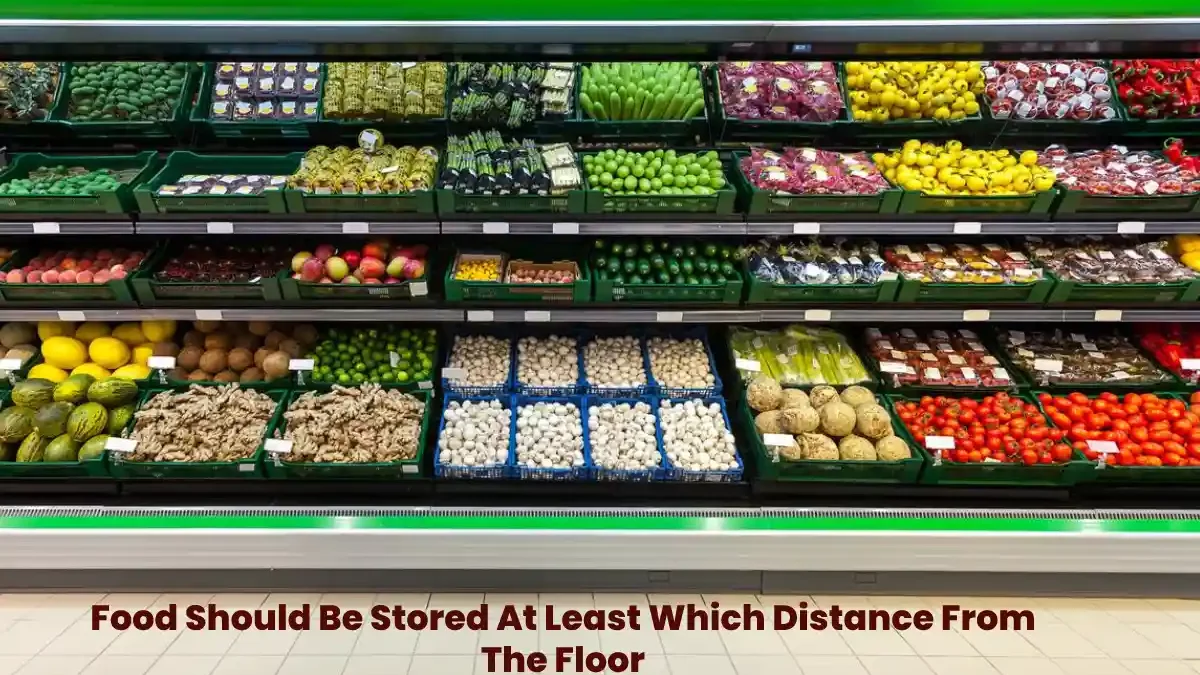Maintaining a minimal distance between food and the floor is critical for preserving freshness and minimizing contamination, as floors can hold dirt, bugs and germs.
Table of Contents
6 Inches
The general food safety guideline is to store food at least 6 inches off the floor. This 6-inch clearance helps protect your food from insects, rodents, water seepage, cleaning chemical residues, grease, vapors, and any other contaminants on the floor. It applies to any shelves, racks, or units used for long-term food storage in pantries, cabinets, refrigerators, freezers, and storage rooms.
Exceptions for Heavy Items
Sturdy packaged foods in cans, bottles, or other sealed containers can sometimes be safely stored under 6 inches. Their protective packaging helps shield contents from floor contamination. This includes unopened soda/water bottles, olive oil tins, beer/wine, and commercial canned goods. But perishable items like meat and produce should always maintain the 6-inch clearance even when sealed.
No Low Storage of Opened Items
Once packaging is opened, that 6-inch distance rule applies. For example, an open bag of flour, cereal, or chips is vulnerable. Keep opened items on elevated shelving or transfer them to airtight containers. Also, avoid direct floor contact with serving bowls, plates, utensils, and other food service wares, which can pick up bacteria.
Above Bottom Shelves
Use lidded bins to elevate items for cupboards, pantries, and cabinets with base shelves just a few inches up from the floor. Do not place any open food containers directly on these low-bottom shelves. Similarly, use lift-up bins on the lowest shelf in the refrigerator rather than storing produce or leftovers now on that shelf.
Not Under Sinks or Leaky Areas
Areas near sinks, tubs, and leaky appliances can get wet, so avoiding under 6 inches of clearance there is crucial. Water leakage promotes mold growth. Even drier areas under sinks see heavy usage of cleaners that could inadvertently contact food. Maintain proper distance from wet floors and under-sink spaces.
Closed Storage Enclosures
Use sealed, water-tight plastic bins or metal containers with latching lids for temporary floor storage of food. This creates a closed enclosure separated from the floor. Ensure containers are sturdy and not leaking. Only use for short-term storage during transport or catering until items can be appropriately shelved.
Clean Regularly Under & Behind
Diligently sweep and mop areas underneath and behind floor-level appliances and cabinetry where food is stored. Clean any spaces beneath, like oven bottoms, weekly to prevent food spills or grease buildup that attract pests. Ensure casters under units roll smoothly for easy mobility when cleaning.
Watch For Mold & Pests
Routinely inspect food storage areas for early signs of mold growth or insect/rodent droppings that signal contamination. Discard any food in opened packaging that appears damaged from proximity to floors. Maintain diligent stock rotation and don’t overload capacity, which causes hard-to-clean floor contact.
Off Mobile Carts & Racks
Verify at least 6 inches of ground clearance underneath once loaded for movable storage units like baker’s racks, carts, and utility tables. Wheels and casters should easily roll over thresholds and level changes. Don’t overload carts in a way that causes bottom shelves to dip down and contact the floor when moving.
Wood Versus Metal
Metal shelving, racks, and containers provide smooth, easily sanitized surfaces compared to wood. But sealed and treated wood also repels moisture and pests. Ensure all units are sturdy and reinforced to hold weight without breaking shelves. Bolt racks to walls for stability and maintain recommended loading limits.
Raised Storage Platforms
Consider permanent or semi-permanent raised platforms like wooden pallets or plastic milk crates to create clean food storage surfaces off the floor. These offer durability over makeshift options like cardboard. Ensure platforms are level, handle heavy weight without collapsing, and separate all food at least 6 inches.
Distance From Walls
In addition to the floor, maintain some clearance between food storage and adjacent walls. Walls attract pests and can endure moisture damage over time. Leave a few inches gap between shelving/cabinets and walls for air circulation and easier cleaning access.
Storage Room Floors
For food storage rooms, avoid concrete or bare floors. Install sheet vinyl, epoxy resin, or sealed tile for durability, crack resistance, and ease of cleaning. Slope floors slightly for drainage and prevent water pooling. Check floors monthly for soundness and immediately repair grout, tile, or coating issues like chips or cracks.
Staff Training
Train all kitchen and pantry staff on proper floor-level food storage procedures. Clearly label acceptable “food storage areas” versus areas near leaky pipes, cleaning supplies, drains, and entrances/exits where food should never be stored due to contamination risks. Monitor staffers periodically to ensure protocol compliance.
Conclusion
Storing food too close to the floor poses safety issues and contamination risks. Following the recommended minimum 6-inch clearance guideline for all food storage allows adequate separation from dirt, allergens, bacteria, moisture, and chemicals on floor surfaces. Keep foods in containers off the floor on elevated shelving units to ensure quality and freshness.



